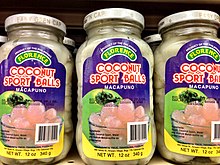 The endosperm of macapuno coconuts are jelly-like and fill almost the entirety of the central cavity in coconut seeds | |
| Alternative names | Coconut sport |
|---|---|
| Place of origin | Philippines (originally domesticated) |
| Region or state | Southeast Asia and the Pacific Islands |
| Associated cuisine | Philippines, Indonesian |
| Main ingredients | Coconut |
Macapuno also called coconut sport, is a naturally occurring coconut cultivar which has an abnormal development of the endosperm. The result of this abnormal development is a soft translucent jelly-like flesh that fills almost the entire central cavity of coconut seeds, with little to no coconut water.[1]
Macapuno was first described scientifically from wild specimens in 1931 by Edwin Copeland. They were cultivated commercially in the Philippines after the development of the "embryo rescue" in vitro culture technology in the 1960s by Emerita V. De Guzman. Although called coconut sport, this mutation is not necessarily a sport in the botanical sense of a mutation arising in part of an adult plant; it may have arisen originally in a seed. It has become an important crop in coconut-producing countries and is now widely used in the cuisines of Southeast Asia and the Pacific Islands.

- ^ Sukendah; Volkaert, Hugo; Sudarsono (2009). "Isolation and Analysis of DNA Fragment of Genes Related to Kopyor Trait in Coconut Plant". Indonesian Journal of Biotechnology. 14 (2): 1169–1178.